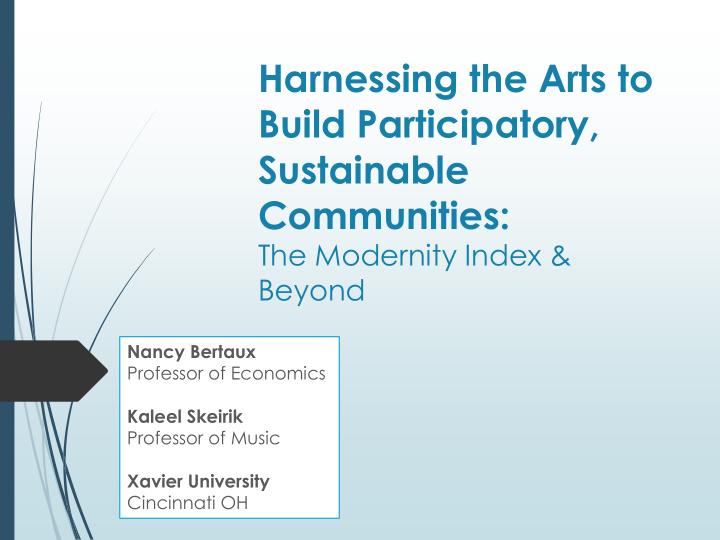



Harnessing the Arts to Build Participatory, Sustainable Communities: The Modernity Index & Beyond Nancy Bertaux Professor of Economics Kaleel Skeirik Professor of Music Xavier University Cincinnati OH
Introduction Some do not yet comprehend concept of finite resources on Earth; Fewer understand (greater?) challenges of waste products from resources we utilize: “sinks may be full before the sources are empty” GHG in atmosphere, acidification of oceans, loss of biodiversity, etc. Consensus on need for urgent action won’t come from science, although science must form foundation for our actions Look to policy- makers? Remarkable inaction, won’t act until public as a whole is motivated and involved Role of ART
Art as Mover Art moves people Through the ages, arts & culture have created MOVEMENTS OF THE HEART and EMOTIONS Art is for all: artists and non-artists alike Arts: performing arts (music, dance, theater), visual and conceptual arts (painting, sculpture, photography, architecture, conceptual), literary arts (poetry, prose, drama, orally transmitted literature
Why the arts? Why focus on modernity, complexity, and equity/inclusion? Measure positive externalities of arts Provide justification for public and private support Explore how the arts intersect with sustainability, community vitality, economic vitality Offer public policy direction
Ansel Adams
Robert Smithson, Spiral Jetty
Samuel Beckett Not I
John Cage , 4’ 33”
Environmental Art (or Eco- Art) Broadest definition: art related to environment Includes wide variety of forms: nature art, site-specific performance, eco-poetry, acoustic ecology, earthworks, eco-disco, bio-art, land art, eco-theater, green activism, ecoventions, social sculpture, etc, etc! Contrast: nature art, social sculpture
Joseph Beuys, 7000 Eichen
Art / Sustainability: Our Model Sustainability Social D Complexity Justice Modernity All ART
Sustainability and the Arts: Modernity, Complexity, & Equity/Justice ONE: Artistic sophistication Usually 2 + levels required in the art Sustainability has multiple intersections with society Art mirrors and exaggerates these relationships Mirroring is through the artist-performer-audience triangle
Art / Sustainability: Our Engagement Model + Art Sustainability Equity & Complexity Justice D C E ? ? Modernity D= Discernment C= Community Engagement E= Experiential Learning
Art and Engagement for Sustainability D: Art is a proven means to Discernment C: Art is presented through Community Engagement E: Art is inherently Experiential Our model postulates that all of these elements deepen the impact of attention to Complexity, Modernity and Equity/Justice
Using Data to Engage Communities, Based on Our Art / Sustainability Models Modernity Index to gauge contemporary vs historical art choices Data Collection on community arts engagement Special focus on deeper and broader engagement with ALL communities Arts as vehicle for diverse cultures and norms Arts as elixir of vitality for neighborhoods and communities
Partnerships for Data and Engagement Recent partner engaged: ArtsWave Cincinnati Oldest and largest umbrella funding organization for the arts in the US Recently expanded number of arts organizations funded from a “traditional” “Big Arts” group of 11, to a diverse and broad-ranging group of 125+ Working together on joint data base to assess the arts’ contributions to community and economic vitality of the region.
ArtsWave’s 5 Key Goals in its Blueprint for Collective Action 1. Arts puts the community on the map 2. Arts deepen roots in the region 3. Arts bridge cultural divides 4. Arts enliven neighborhoods 5. Arts fuel creativity & learning We are partnering especially on #3 & #4, with sustainability envisioned as a key element in community vitality
Using Modernity Index Expanded from original Cincinnati Symphony Orchestra data base to calculate modernity trends in a variety of regional art organizations, including: Playhouse in the Park Cincinnati Shakespeare Company Cincinnati Ballet
Other Data to be Shared / Collected "Arts ripple effects” data (previous analysis by ArtsWave( Market segmentation analysis of art industry in Cincinnati Detailed snapshots of landscape of arts industry Subdivide data by chosen sub-categories (e.g., type of art, neighborhood(s) served, size of audience)
Other Data to be Shared / Collected Efficiency / elasticity analysis of donations / fees Analyze costs of fund-raising vs. income received for efficiency measures Calculate relevant elasticities, for example: How does increased investment in fund- raising efforts compare to changes in amounts of income received? How do arts event ticket prices relate to size of audience at event? How does this vary over market segments?
Questions? Nancy Bertaux, Bertaux@Xavier.edu Kaleel Skeirik, Skeirik@Xavier.edu
Recommend
More recommend